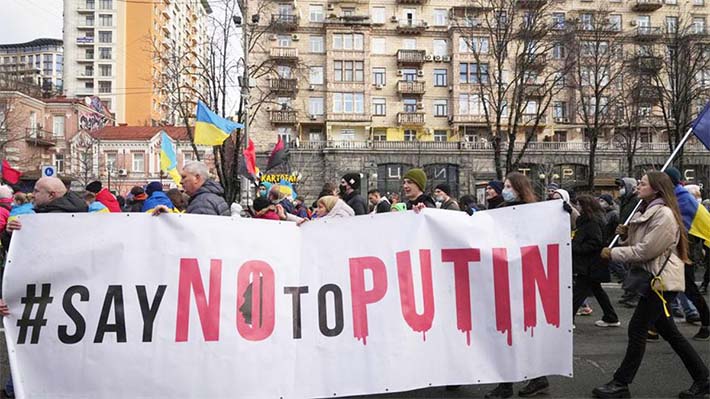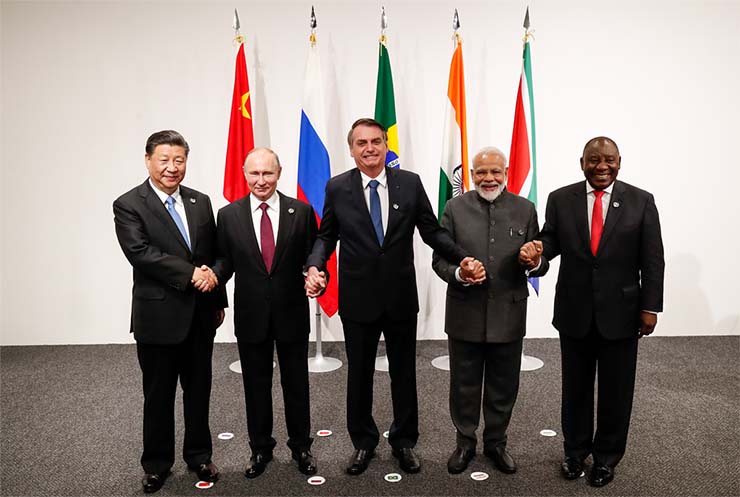
The current global environment reflects dynamic and transformational geopolitical factors that portend the rise of a new world order in the not-too-distant future. India, by virtue of its economic growth, demography, growing industrial strength and entrepreneurship is in a momentous timeframe of power transition necessitating its active role in a transforming world. Much of this emanates from the geopolitical fall-out of the ongoing war in Ukraine. This war has brought to the fore the importance of geopolitics, economic structures of the world order, technology, and the continuing use of war as a tool of global politics.
Geopolitical Competition
The interplay of geography and politics makes geopolitics an ever-present phenomenon. The return of great power rivalry is the most important development in the 21st century. India as a rising power cannot be impervious to this development. A deeper understanding of the geopolitics of the Ukraine war is necessary to understand why a new multipolar world order is inevitable. The causal factors lie in the existing dominance of the world order by the West. The real power of the west is in its domination of the international financial system evolved from colonial and imperialist structures through mercantilist and international banking processes. The West (USA and Western Europe), aided by colonial possessions and the industrial revolution, established itself as the core of the world economy while rest of the world were made peripheral economies. Colonialism and imperialism allowed the West to occupy much of the non-Western world and use extractive economic processes to build their wealth and fund their development. It also led to increasing geopolitical rivalry resulting in increasing number of wars, culminating in the two world wars of the 20th century. Geopolitical rivalry stems from economic competition for dominance.
The West, led by the USA created the post-1945 world order and through the Bretton Woods Agreement established the financial structures and multilateral institutions for global governance. The international financial system supported capitalist model, created US dollar as the global reserve currency and strengthened the USA’s control of the world’s economic levers. The USSR, with its socialist model, stayed out of the Bretton Woods system. As colonialism ended, a bipolar world order emerged with competing political ideologies of the two superpowers, the USA, and the USSR. While geopolitical competition and proxy wars ensued, the bipolar system provided stability and deterrence during the Cold War. India’s spearheading of the Non-Aligned Movement created a bloc of large number of Non-Aligned countries but lacked effectiveness due to lack of military power, technological, and economic heft. The Collapse of the Bretton Woods model in the 1970s enabled the USA to strengthen its control by dumping the gold standard and creating the petrodollar.
The end of the Cold War and the collapse of the USSR led to the unipolar dominance and hegemony of the United States. This unipolar dominance is more strongly reflected in the USA’s complete control of the global financial system including the IMF, World Bank, WTO, and monetary transaction system such as the SWIFT. At the peak of its unipolar moment, 85 per cent of global foreign exchange reserves were held in the USD. Effectively, the USD’s role as the global reserve currency compromised the sovereignty of most nations as their investments and reserves, and in turn their developmental challenges were influenced by the dollar hegemony. The rise of the Euro zone presented the first minor challenge to the dominance of the dollar. Similarly, the rise of China and India, resurgence of Russia, and other emerging economies are gradually beginning to dilute the dominance of the USD.
Geopolitics of War and Hegemony
Clausewitz famously said, “War is a continuation of politics by other means”. Wars in the 21st century clearly prove this dictum. USA’s intervention wars since 1991 reveal its strategy of consolidating its unipolar dominance and shaping the global economic order to its benefit. The crux of geopolitics is to establish control over economic resources in a geography through demolishing or weakening the political entity. The Iraq war effectively led to control of its oil resources and monetary reserves in the hands of the West. Since then, the US and its allies have been engaged in intervention wars, with and without UN endorsement. These have been wars against much weaker nations – former Yugoslavia, Iraq, Afghanistan, Syria, Libya, Yemen, etc. Between 2005 and 2022, a lot has changed in terms of geopolitical landscape.

The rise of China as a global economic, technological, and military power; rise of India as a major economy; resurgence of Russia as a great power; and the rise of alternative multilateral institutions such as BRICS, SCO, New Development bank, AIIB, and the massive global infrastructure investment project BRI, are now posing a challenge to US’ hegemony. The US has reacted strongly by weaponising the dollar and imposing sanctions on various countries. Since the dollar is the global reserve currency and economic structures like the SWIFT, IMF, and the WB are in USA’s control, this weaponisation of the dollar through sanctions have had very adverse impacts on nations like Iran, Iraq, North Korea, Syria, Afghanistan etc. The US and the West’s use of force and coercive strategies have increased significantly.
What does the Ukraine War indicate?
The war in Ukraine is effectively a proxy war by the US and NATO against the Russian Federation. This is a war to weaken a great power while a parallel strategy has been set in motion to contain and constrain economically and technologically the peer competitor, China. The seeds of Ukraine conflict were sown in the 1990s as suggested in Zbigniew Brzezinski’s strategic prescription in his 1997 book ‘The Grand Chessboard’. While the Soviet Union collapsed, taking with it the Warsaw Pact entity, NATO began to expand into the Russian sphere of influence. The NATO, which logically should have wound down just like the Warsaw Pact, expanded its scope, clearly a geopolitical objective of seizing control of the Eurasian pivot. The objective of this war, as the US Defence Secretary said, is to weaken Russia and if possible, fragment it. By initiating a war against another great power, the war in Ukraine is a major geopolitical escalation. The war, in its conduct as well as the resultant geopolitical and geoeconomic alignments signals many warnings for rest of the world.
Since 1991, the US and NATO have resorted to interventions, wars, and sanctions unilaterally in many parts of the world. A deeper study of these interventions reveals that these interventions benefitted the West to control resources and businesses apart from geopolitical objectives of regime changes. A resurgent Russia moved in to support Assad in Syria while many African countries have criticised the destruction of Libya. China has increased its influence in Africa and South America at the expense of the US and its allies.
Between 1997 and 2021 the US and NATO allies were at war in various countries from former Yugoslavia, to Iraq, Afghanistan, Libya, Syria, and Yemen in addition to imposing severe economic sanctions on Iran and Venezuela. Russia’s invasion of Ukraine can be seen as a provoked response to an increasingly existential threat. Ukraine war has enabled the USA to consolidate its hold on allies in Europe, Japan, Australia, and New Zealand. The US objectives are manifold: 1. Revive, strengthen, and expand NATO, 2. Decouple Europe’s economic linkages to Russia and China, 3. Weaken European Union and increase its alignment and dependency on the US, 4. Increase defence spending in Europe with consequent benefits to American military industrial complex, 5. Keep Ukraine in turmoil and weaken Russia through a long-term conflict engagement in Ukraine, 6. Get the world to align with the West and isolate Russia and China, 7. Reduce China’s influence and severe its global supply chains 8. Convince emerging powers like India into American alliance system, 9. Enable AAKUS to become a NATO-like military alliance to contain China, 10. Sustain dollar hegemony.
Conduct of the war has highlighted the importance of technology and supply chain controls, intelligence and ISR, cyber security, and the decreasing effectiveness of sanctions. America’s unilateral sanctions on Russia have brought reverse impact on Europe and much of the world. It has strengthened the strategic partnership of Russia and China. American attempts at controlling semi-conductor chip supplies to China and Russia, with the hope of impacting their weapon systems seems to have been foreseen and circumvented. American sanctions have initiated a backlash against the dollar. Recent events indicate the world’s move towards de-dollarisation. Geopolitically the war is strengthening China’s stature as evidenced by its mediator role in Saudi-Iran relations, and in ending the conflict in Yemen.
India’s Options
For India this is an inflexion point in its strategic autonomy. India, while remaining neutral, must actively work to facilitate the emergence of a multipolar world. For this it needs to accelerate its economic growth, technological independence, and build a strong indigenous arms industry. India’s hard power growth is vital if it is to emerge as a rule maker in a multi-polar world. Hence, it’s ‘make in India’ strategy should be intelligently implemented while building and sustaining strategic partnerships with other major powers on both sides, USA and Russia included.
BRICS is emerging as the most important organisation that will facilitate the emergence of a multi-polar world. There are nearly 12 countries, including Saudi Arabia, Iran, Argentina, and Mexico that have applied to become BRICS members. As a founding member of BRICS, India can hone its strategy of non-alignment 2.0. This time it is a different process as BRICS works from a position of economic, military, and political strength. India’s chairmanship of SCO and G20 strengthens its position. This is India’s moment of transformation from being a rule taker so far to become one of the rule makers for global governance in the 21st century.
-The writer is a former Deputy Chief of Integrated Defence Staff. Recipient of AVSM VM & PhD, he is currently the President of the Peninsula Foundation. The views expressed are personal and do not necessarily reflect the views of Raksha Anirveda








